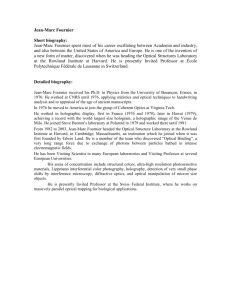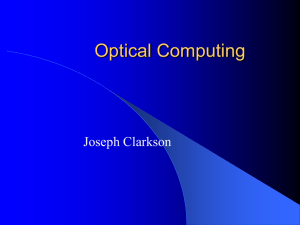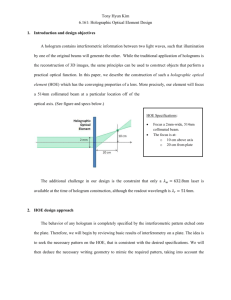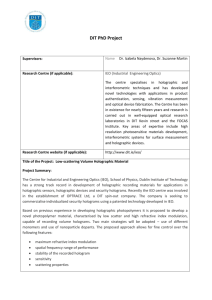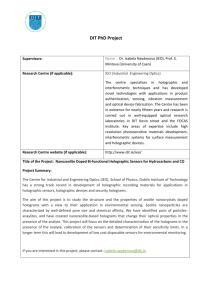lit_review 4 - petgers3030wiki
advertisement
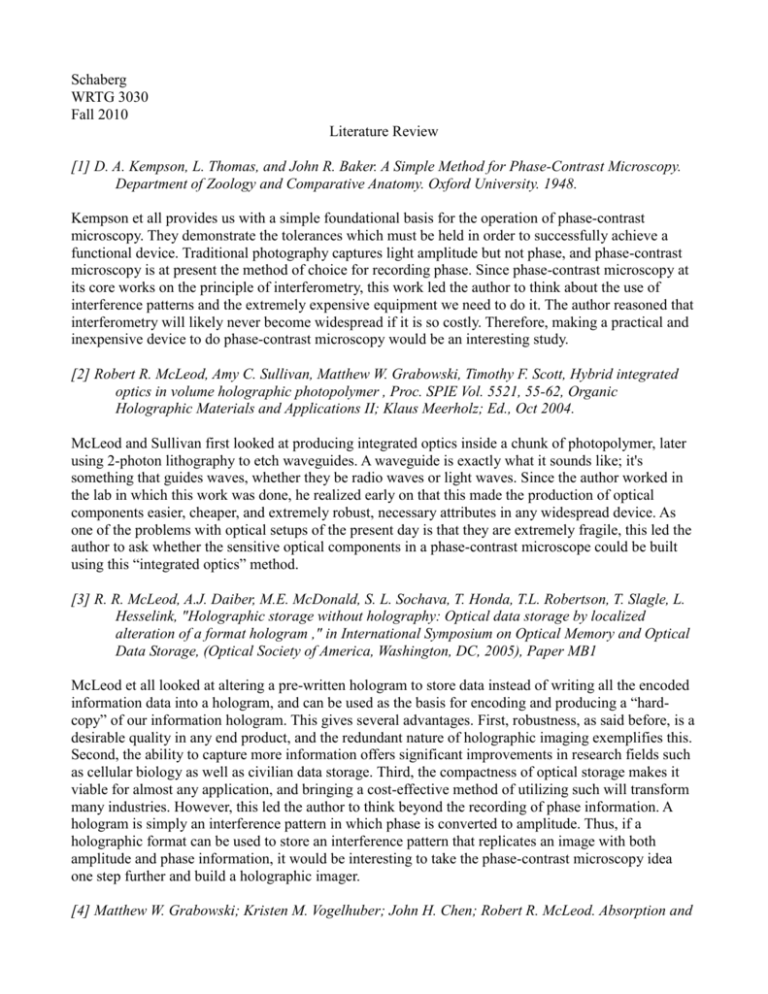
Schaberg WRTG 3030 Fall 2010 Literature Review [1] D. A. Kempson, L. Thomas, and John R. Baker. A Simple Method for Phase-Contrast Microscopy. Department of Zoology and Comparative Anatomy. Oxford University. 1948. Kempson et all provides us with a simple foundational basis for the operation of phase-contrast microscopy. They demonstrate the tolerances which must be held in order to successfully achieve a functional device. Traditional photography captures light amplitude but not phase, and phase-contrast microscopy is at present the method of choice for recording phase. Since phase-contrast microscopy at its core works on the principle of interferometry, this work led the author to think about the use of interference patterns and the extremely expensive equipment we need to do it. The author reasoned that interferometry will likely never become widespread if it is so costly. Therefore, making a practical and inexpensive device to do phase-contrast microscopy would be an interesting study. [2] Robert R. McLeod, Amy C. Sullivan, Matthew W. Grabowski, Timothy F. Scott, Hybrid integrated optics in volume holographic photopolymer , Proc. SPIE Vol. 5521, 55-62, Organic Holographic Materials and Applications II; Klaus Meerholz; Ed., Oct 2004. McLeod and Sullivan first looked at producing integrated optics inside a chunk of photopolymer, later using 2-photon lithography to etch waveguides. A waveguide is exactly what it sounds like; it's something that guides waves, whether they be radio waves or light waves. Since the author worked in the lab in which this work was done, he realized early on that this made the production of optical components easier, cheaper, and extremely robust, necessary attributes in any widespread device. As one of the problems with optical setups of the present day is that they are extremely fragile, this led the author to ask whether the sensitive optical components in a phase-contrast microscope could be built using this “integrated optics” method. [3] R. R. McLeod, A.J. Daiber, M.E. McDonald, S. L. Sochava, T. Honda, T.L. Robertson, T. Slagle, L. Hesselink, "Holographic storage without holography: Optical data storage by localized alteration of a format hologram ," in International Symposium on Optical Memory and Optical Data Storage, (Optical Society of America, Washington, DC, 2005), Paper MB1 McLeod et all looked at altering a pre-written hologram to store data instead of writing all the encoded information data into a hologram, and can be used as the basis for encoding and producing a “hardcopy” of our information hologram. This gives several advantages. First, robustness, as said before, is a desirable quality in any end product, and the redundant nature of holographic imaging exemplifies this. Second, the ability to capture more information offers significant improvements in research fields such as cellular biology as well as civilian data storage. Third, the compactness of optical storage makes it viable for almost any application, and bringing a cost-effective method of utilizing such will transform many industries. However, this led the author to think beyond the recording of phase information. A hologram is simply an interference pattern in which phase is converted to amplitude. Thus, if a holographic format can be used to store an interference pattern that replicates an image with both amplitude and phase information, it would be interesting to take the phase-contrast microscopy idea one step further and build a holographic imager. [4] Matthew W. Grabowski; Kristen M. Vogelhuber; John H. Chen; Robert R. McLeod. Absorption and Bleaching Dynamics of Initiator in Thick Photopolymer Exposed to Gaussian Illumination. University of Colorado. Colorado Photonics Industry Association, 2008. The author worked with Grabowski in studying the bleaching properties of photosensitive polymer materials. This paper led gives a more thorough understanding of controlling the parameters when writing data to holographic format. In order for hard-copy holography to be practical, we must be able to transport the film without fear that it will over-bleach or degrade in the presence of light. In addition, this led the author to think about medium that could be used to transport the holographic image data. Transporting data encoded on glass panes inevitably sounds like the work of a clandestine agent, and a military application immediately arises. If [airborne] front-line surveillance uses holographic imaging to watch enemy targets, the “hard-copy” can be sent to rear-admirals in holographic format. Because the hologram contains amplititude and phase information at extremely high resolution and redundancy, this makes an ideal medium for capturing the maximum amount of information for tacticians. [5] A. C. Sullivan and R. R. McLeod. Tomographic reconstruction of weak, replicated index structures embedded in a volume. Opt. Express 15, 14202-14212 (2007). Sullivan’s work focused around the identification of differently indexed structures based on diffraction tomography, a process of shining a laser into an unknown structure and reconstructing the internals based on an inverse Fourier transform of the output. The author was led to think about what to do with poor or underdeveloped images. This work therefore helps reconstruct the image based on a diffraction grating and is fundamental in allowing us to reconstruct weak or poorly exposed images. The analog nature of the imaging means that we can always get some data out of our image. The work was later duplicated by the author and two others, which did not result in a paper, but contributed greatly the understanding of the principles behind it. This learning led the author to think about what this type of work could teach to new students of the field. [6] C. E. Wieman et al. Modern Physics for Engineers: Summary of Topics, Methods, and Common Student Difficulties. Physics 2130 Archive. University of Colorado at Boulder. <http://www.colorado.edu/sei/2130archive/ModernPhysicsSummary.pdf>. Wieman has compiled a short writeup of the common difficulties of students in a large lecture physics class. This writeup demonstrates very clearly elucidates the key concepts even to an outsider of the field (such as myself). It exemplifies why certain things must be taught in certain ways and expounds, if only briefly, about why students have difficulty with each of the concepts. For example, he notes that about 40% of class thinks charges moving at constant speed generate light. They think this because of various reasons(charges in light bulb filament move at constant speed, a spark is a charge moving at constant speed, or they don’t see why it wouldn’t). He also describes other difficulties, such as Students have a much harder time thinking of electrons as waves than photons, because electrons have mass. Students often think that the size of the wave packet, rather than the wavelength, should determine the spacing of the interference pattern. The fact that these are so cleanly identified allows the author to wonder at the common difficulties of students in the field of optoelectronics. In addition, since the building of a holographic imager requires so many of the fundamental principles of modern optoelectronics, it would be beneficial to apply this model to a curriculum. That is, students learn each of the subjects (interferometry, sources, imaging, coherence, detectors, digitization, light sensitive film, and optical storage) and apply them to a project to build a holographic imaging system as their ultimate goal. In addition, Wieman describes ways that he addresses the problems, such as We teach spectra before the Bohr model in order to emphasize how Bohr was able to explain the observed spectra with his model. Students often have trouble with the idea that the energy of light corresponds to the difference between the levels rather than the values of the levels. They need lots of explicit practice to get this distinction straightened out. The fact that we often use the symbol V for potential energy and use the words “potential” and “potential energy” interchangeably leads to a lot of students thinking that V is actually the electric potential. It is worth emphasizing repeatedly that this is NOT what it means. We have chosen to cover expectation values in some semesters and not others. It helps to relate it to more familiar examples such as grade distributions and gambling. These solutions are here because they have been tried and tested in practice. This approach begs to be crossed over into the teaching of optical engineering to undergraduates, which we investigate. [7] C. E. Wieman et al. Learning Goals. Physics 2130 Archive. University of Colorado at Boulder. <http://www.colorado.edu/sei/2130archive/2130LearningGoals.pdf>. Following from the common difficulties, Wieman has compiled a list of common learning goals of the course. This text supplemented the difficulties in setting a structure for which the physics class is taught. This allows us to see what is important and should be stressed, as failure to do so often leads to confusion in undergrad education. Following from the previous source, this led the author to realize that the first step in undergraduate optics education is naming the learning goals of said education, further cementing the idea of a unified curriculum that is geared toward a project demonstrating the goals and principles thereof. [8] S. B. McKagan, K. K. Perkins and C. E. Wieman. Reforming a large lecture modern physics course for engineering majors using a PER-based design. Department of Physics. University of Colorado at Boulder. <http://www.colorado.edu/sei/2130archive/McKaganPERCproceedings2006.pdf>. McKagan writes with Wieman about reforming the same physics class as above with what he calls the PER design. It is seen that the principles established by such a design are aimed at improving the ability to learn in these classes. In examining the assumptions made in the design and why they are beneficial, the author came saw a sharp contrast between this research and how traditional educational research is done. Since the author has some background in education, he realized that it may not be up to education majors to do research in education but the individual teachers in the field, since the best approach to teaching in every field is different. [9] J. Galang, A. Restelli, E. W. Hagley, and C. W. Clark. A Red Light for Green Laser Pointers. OPN Optics and Photonics News. p. 11-13. Optical Society of America. Galang et all investigate the unknown and often dangerous emission of infared radiation from ordinary green laser pointers. In doing so, they demonstrate simple, key principles in optics and linear systems in a concise, straightforward manner. The article is written for a professional optics journal but could easily be published in a high-school text. This study was done extremely low budget, with the setup consisting of a plastic cup, paper, laser pointer, and digital camera without an infared filter. This study influenced the author to take the project into an educational branch and pointed out that such studies do not need to be prohibitively expensive to allow undergraduates to do them. [10] L. F. Mollenauer and D. H. Olson. Simple optical absorption spectrometer suitable for measurements at low temperatures. Bell Telephone Laboratories Inc. Feb. 18 1975. The American Institute of Physics. Mollenauer and Olson describe a simple method for building an absorption spectrometer without extremely costly equipment for low-temperature(ie. room temperature) measurements. In doing so, they demonstrate the principles that are necessary for the understanding of the absorption spectrometer. In addition to being an important starting point for undergraduate optical engineering, these ideas led the author to a holographic imager which is a simple device at its core. The extraneous features can and should exist outside of this central component for graceful degradation. This is applied to the interferometry for our device. In addition, the separation of components and avoidance of an overcomplicated, feature-rich central box improves the ability of the project to be utilized for undergraduate teaching, as the core principles are more readily accessible.
